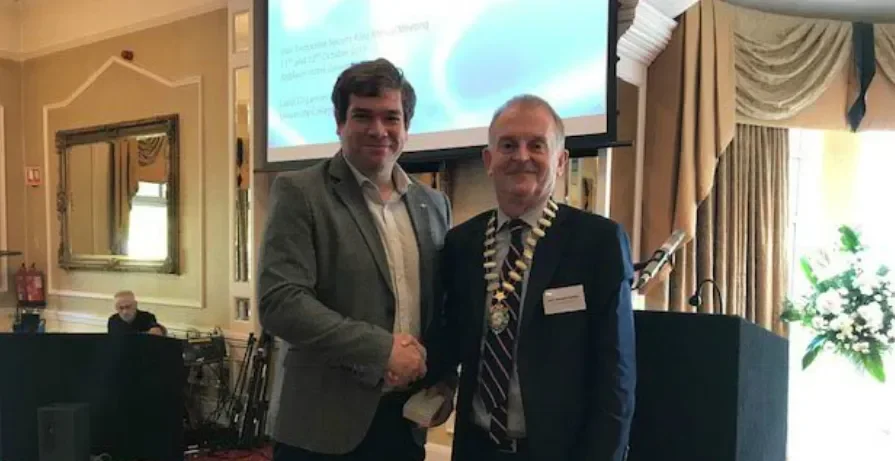

DCU Researcher Takes Top Prize At Irish Endocrine Society Meeting
The Irish Endocrine Society’s prestigious O’Donovan medal has been awarded to Dr. Keith Rochfort for his research into a novel therapeutic strategy for diabetic retinopathy.
The medal was presented to Dr. Rochfort by the president of the society, Prof. Brendan Kinsley, at the conclusion of the Irish Endocrine Society’s 43rd Annual Meeting.
Organised by University College Hospital Galway, the IES Annual Meeting played host to researchers and clinicians from across Ireland working in the field of endocrinology. Over the course of two days, 22 talks and 149 posters were presented, and included topics such as advancements in diabetes therapeutics and treatments, outcomes of clinical trials, and unique patient case studies.
‘The Irish Endocrine Society Annual Meeting is an excellent forum for seeing the breadth of research in the field of diabetes in Ireland today,’ says Dr. Keith Rochfort. ‘Having the opportunity to engage with those of diverse research backgrounds within the field of endocrinology at these meetings has been fundamental in shaping our understanding of this disease, paving the way for novel therapeutic interventions.’
 Working with the Endothelium Biology Group led by Assoc. Prof. Phil Cummins of the School of Biotechnology, the group has published consistently in the area of vascular physiology and associated microvascular complications of diabetes.
Working with the Endothelium Biology Group led by Assoc. Prof. Phil Cummins of the School of Biotechnology, the group has published consistently in the area of vascular physiology and associated microvascular complications of diabetes.
‘Cardiovascular-related death remains the leading cause of mortality in diabetes. With diabetic retinopathy, now the leading cause of blindness in working age individuals today, elevated blood glucose can cause disruption of retinal capillaries, which, if left untreated, can ultimately lead to visual impairment.’
Brought together by Science Foundation Ireland’s US-Ireland R&D Partnership programme, Drs Rochfort and Cummins have been working with Queens’ University Belfast, the Moran Eye Centre at the University of Utah, and the Loma Linda University of California, in utilising a novel mimetic of angiopoietin-1 referred to as COMP-Ang1; a molecule capable of exerting a protective effect on the vasculature in the treatment of diabetic retinopathy.
‘We found that diabetic levels of glucose have a largely disruptive effect on endothelial cells that line retinal capillaries, causing these tiny vessels to become leaky. Our research in human cell models has shown that treatment with COMP-Ang1 can reverse this effect restoring the barrier function of the capillary to near normal levels under diabetic conditions, clear evidence of therapeutic potential. These findings were recently reported by our group in the leading US visual sciences journal Investigative Ophthalmology and Visual Science (IOVS). Our consortium is also developing a viral-based strategy to deliver this treatment into the eye for lasting improvements in vision.’
‘In preliminary findings we have found after a single administration of our viral-based therapy we can achieve sustained normalisation/repair of the diabetic retinal capillaries. This research represents a significant step towards creating an effective option for not only those whom current therapeutics have ceased working, but also for other diabetic sufferers who could save and maintain their vision long-term with a single treatment.’
For more information, the group’s latest publication can be viewed here.
